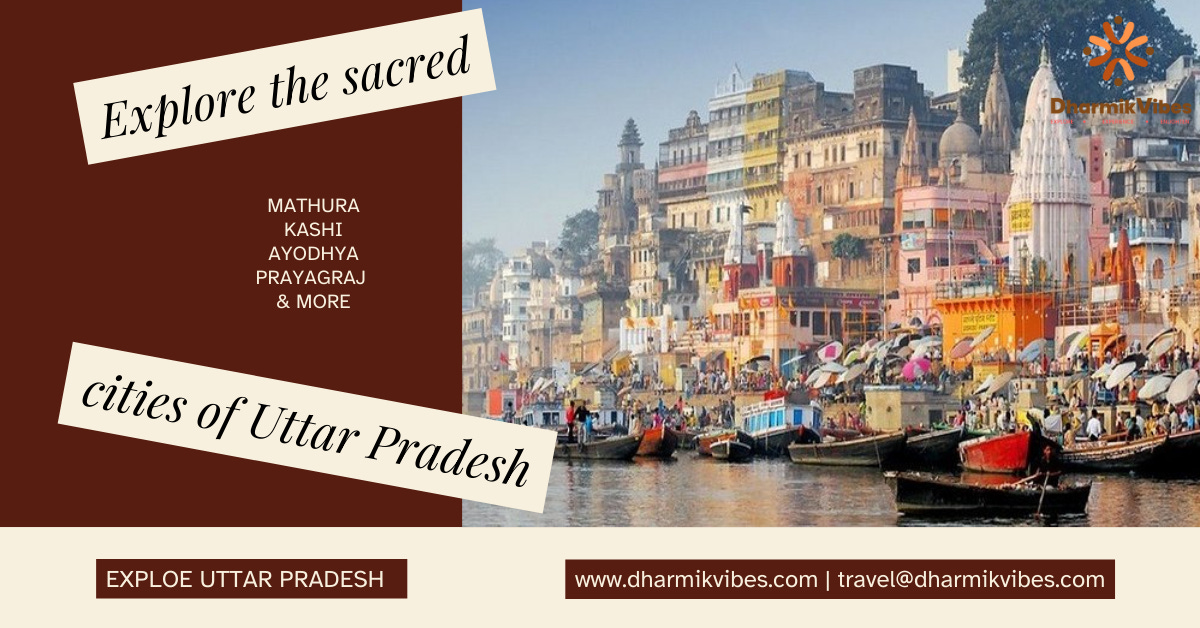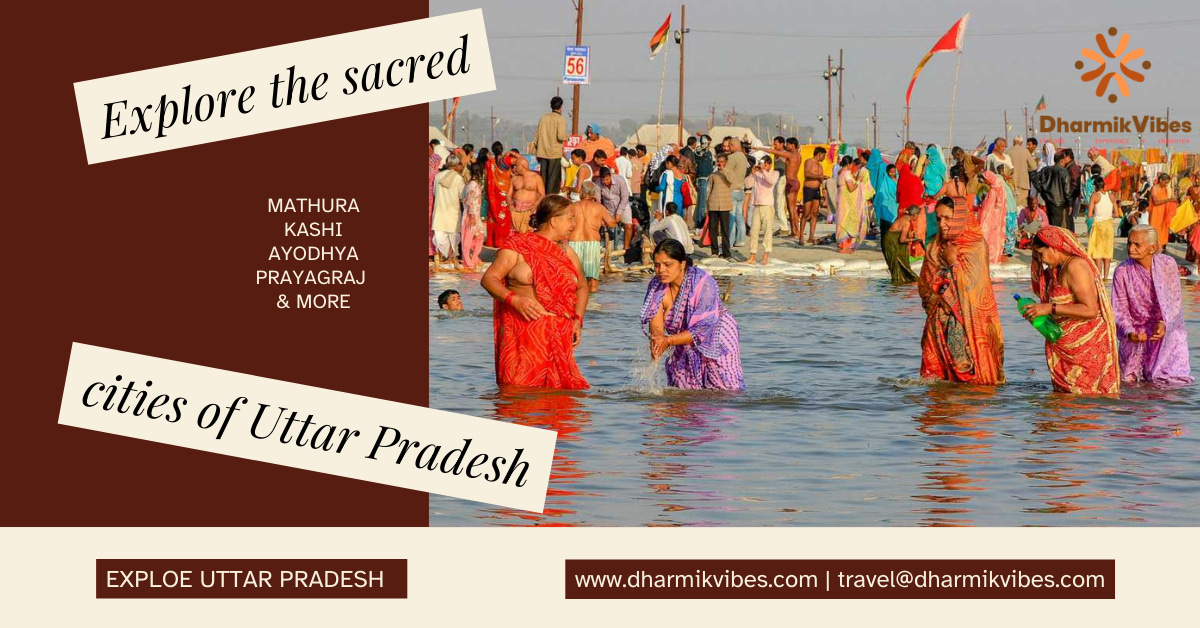Uttar Pradesh Religious Series Part 5: Synthesis, Contemporary Adaptations, and Future Directions in Uttar Pradesh’s Spiritual Landscape
Uttar Pradesh’s spiritual legacy is a living mosaic composed of centuries‑old traditions, regional variations, and personal narratives. In this final segment, we bring together the insights gathered from our in‑depth journey—from the legendary tier‑1 pilgrimage centers of Varanasi, Prayagraj, Mathura, Vrindavan, and Ayodhya; through the hidden gems of tier‑2 and tier‑3 locales; to the intimate, grassroots expressions in rural tirths. We explore how modernity is interwoven with tradition and consider strategies for preserving this rich cultural tapestry for future generations.
1. The Enduring Spirit of Uttar Pradesh: A Synthesis of Ancient Traditions
a. A Tapestry of Devotion
Uttar Pradesh’s spiritual culture is defined by its ability to evolve while remaining anchored in its past. At the heart of this evolution lies the unwavering devotion of millions:
Timeless Rituals: Daily aartis, pujas, and communal celebrations continue to be the backbone of religious practice. Whether it is the sacred dip in the Ganges or the intimate recitations at village shrines, these rituals have endured as acts of faith across generations.
Myth and Memory: The narratives of deities like Krishna, Rama, and Shiva have shaped the identity of entire regions. Stories handed down orally or inscribed in temple walls not only inspire art and literature but also foster a shared identity among devotees.
Cultural Continuity: Festivals such as Kumbh Mela, Janmashtami, Ram Navami, Holi, Diwali, and regional melas serve as annual reaffirmations of this cultural continuity. These events blend myth, ritual, and art into communal experiences that are both personal and collective.
b. The Architectural and Artistic Legacy
The religious architecture of Uttar Pradesh stands as a testament to the state’s historical depth and aesthetic ingenuity:
Temples and Ghats: Iconic structures like the Kashi Vishwanath Temple, Shri Krishna Janmabhoomi, and the ghats of Varanasi are not only places of worship but also living museums where art, architecture, and spirituality converge.
Regional Art Forms: From intricate stone carvings and terracotta sculptures in rural shrines to the vibrant murals of urban temples, the art of Uttar Pradesh embodies the state’s cultural syncretism. These works of art tell stories of divine play, heroic sagas, and the eternal struggle between light and darkness.
Folk Performances: Traditional dances, Ramlila performances, and devotional music are expressions of the state’s living heritage. They bridge the gap between the ancient and the contemporary, inviting both young and old to participate in a dynamic dialogue with the divine.
2. Contemporary Adaptations: How Modernity Meets Tradition
As Uttar Pradesh strides into the modern era, its spiritual landscape is adapting to contemporary challenges while preserving its core values. This section examines several case studies and initiatives that highlight how ancient practices are being maintained—and even enhanced—through modern means.
a. Digital Devotion and the Global Reach of Tradition
Leveraging Technology for Spiritual Outreach:
Live-Streaming and Social Media: Many temples, even in remote villages, have embraced digital platforms to broadcast daily rituals, special events, and festival celebrations. For example, the morning Ganga Aarti at Dashashwamedh Ghat is now streamed online, allowing devotees worldwide to participate in real time.
Digital Archives and Documentation: Cultural organizations and academic institutions in Uttar Pradesh are actively working to digitize ancient manuscripts, oral histories, and temple art. These digital archives serve as both educational resources and repositories of the state’s spiritual legacy.
Online Community Engagement: Social media groups and dedicated mobile applications have become hubs for sharing devotional content, event schedules, and community initiatives. These digital spaces help bridge the geographical divide, connecting rural practitioners with urban devotees and global audiences.
b. Sustainable Tourism and Community-Led Initiatives
Balancing Economic Development with Spiritual Preservation:
Homestays and Cultural Tours: Local communities are partnering with tourism boards to offer authentic homestays and guided tours that provide visitors with immersive experiences of local festivals, temple rituals, and artisan workshops. These initiatives not only generate revenue but also ensure that the cultural heritage is shared respectfully and sustainably.
Community Training and Empowerment: Workshops and training programs are being organized to educate local youth in traditional arts, temple management, and heritage conservation. By equipping new generations with these skills, communities ensure the continuity of their spiritual and cultural practices.
Environmental Conservation: Recognizing the symbiotic relationship between nature and spirituality, local NGOs and government bodies are working to protect sacred groves, water bodies, and historical sites. Initiatives include reforestation projects, clean-up drives, and the promotion of eco-friendly pilgrimage practices.
c. Educational Outreach and Cultural Revitalization
Reviving Oral Traditions and Folk Arts:
Cultural Curricula in Schools: Several districts in Uttar Pradesh have integrated local folklore, traditional music, and mythological studies into their school curricula. This educational outreach ensures that the cultural and spiritual heritage is passed on to younger generations.
Folk Art Workshops: Artists and cultural experts conduct workshops on traditional dance forms, music, and crafts. These sessions not only serve as cultural education but also help preserve endangered art forms.
Inter-Generational Dialogues: Community events that bring together elders, artisans, and youth foster a space for sharing stories, experiences, and visions for the future. These dialogues strengthen the communal bond and reinforce the importance of preserving heritage in the face of rapid change.
3. Case Studies: Stories of Transformation and Continuity
a. The Transformation of a Village Temple
In a small village in Ambedkar Nagar, a centuries‑old temple underwent a thoughtful renovation that combined modern amenities with traditional aesthetics:
The Renovation Process: Local artisans, in collaboration with state heritage bodies, restored the temple’s ancient frescoes and stone carvings. Modern infrastructure improvements—such as solar lighting, clean water facilities, and improved access roads—were integrated without altering the temple’s original design.
Community Impact: The revamped temple not only attracted more visitors but also served as a catalyst for local economic development. Monthly cultural programs, devotional concerts, and artisanal fairs now take place at the temple complex, revitalizing the community’s spiritual and cultural life.
b. Digital Initiatives at Varanasi Ghats
In Varanasi, a pioneering project has transformed the way devotional practices are experienced:
The Digital Aarti Initiative: Recognizing the global interest in Varanasi’s spiritual practices, local priests collaborated with tech enthusiasts to set up a live-streaming service for the daily Ganga Aarti. High‑quality video and audio capture the mesmerizing rituals, allowing people from around the world to witness this sacred ceremony.
Global Engagement: The initiative has not only increased digital engagement but also provided a platform for interactive sessions with spiritual leaders. This digital outreach has enhanced the understanding and appreciation of Varanasi’s spiritual legacy among a global audience.
c. Reviving Folk Theatre and Ramlila Performances
In the rural heartlands of Uttar Pradesh, traditional Ramlila performances—once at risk of fading away—are experiencing a revival:
Community Ramlila Projects: In several villages, local artists and storytellers have revived Ramlila performances by incorporating traditional narratives with innovative stage techniques. These performances are often held during Ram Navami and Dussehra, drawing large local audiences and even visitors from neighboring areas.
Cultural Exchange and Workshops: Organized workshops on folk theatre and traditional storytelling have empowered local performers. These sessions also serve as a platform for inter-generational learning, ensuring that the nuances of the art form are meticulously passed down.
4. Reflections on the Interplay of Tradition and Modernity
a. Preserving the Past, Embracing the Future
Uttar Pradesh’s spiritual landscape is a dynamic interplay between the immutable and the evolving:
The Role of Tradition: At its core, the state’s cultural identity is anchored in its ancient traditions—rituals that have been performed for centuries, myths that have shaped communities, and art forms that have evolved in tandem with spiritual beliefs.
The Winds of Change: Modernity brings with it new technologies, new audiences, and new economic models. Yet, rather than displacing tradition, these modern elements have the potential to enhance the reach and relevance of Uttar Pradesh’s spiritual heritage.
A Harmonious Coexistence: The success stories from digital initiatives, sustainable tourism, and community education are proof that innovation can go hand in hand with preservation. When modernity is applied thoughtfully, it can serve as a bridge connecting the past with the future.
b. Challenges and the Road Ahead
Despite inspiring transformations, several challenges remain:
Economic and Environmental Pressures: Urbanization, environmental degradation, and economic disparities continue to threaten the integrity of sacred sites and traditional practices.
Cultural Commodification: The commercialization of pilgrimage—if left unchecked—may risk diluting the spiritual essence of Uttar Pradesh’s heritage.
Intergenerational Disconnect: As younger generations increasingly migrate to urban centers, the transmission of oral traditions and local customs faces the threat of discontinuity.
Strategic Pathways Forward:
Integrated Policy Frameworks: Government bodies, cultural organizations, and community groups must collaborate to create policies that safeguard heritage sites, promote sustainable tourism, and support cultural education.
Leveraging Technology: Expanding digital documentation, virtual tours, and online archives can ensure that even if physical proximity to sacred sites is lost, the knowledge and experience remain accessible.
Community Empowerment: Empowering local communities to take leadership roles in cultural preservation can ensure that traditions are maintained from within, fostering a sense of ownership and pride.
5. Concluding Reflections: A Living Legacy
Uttar Pradesh stands as a testament to the power of faith, art, and community. Its spiritual heritage is not a relic of the past but a vibrant, ever‑evolving legacy that continues to inspire, unite, and transform:
A Tapestry of Lives: Every temple, every ritual, every festival in Uttar Pradesh is a thread in a vast tapestry woven over millennia. This tapestry is enriched by the countless devotees who have, and continue to, infuse it with life.
The Role of the Modern Devotee: Today’s spiritual seeker has the unique opportunity to engage with tradition in multifaceted ways—through physical pilgrimages, digital connections, and immersive cultural experiences. This multifarious approach ensures that the divine narrative of Uttar Pradesh remains relevant in a globalized world.
A Call to Preserve and Innovate: As custodians of this ancient legacy, it is incumbent upon us—be it community leaders, policymakers, scholars, or individual devotees—to work together in preserving this treasure trove while embracing the tools of modernity. Only then can we ensure that the spiritual map of Uttar Pradesh continues to guide future generations on a journey of discovery, reflection, and transcendence.
Final Thoughts
In this five‑part series, we have traversed the sacred landscapes of Uttar Pradesh—from its bustling, world‑renowned pilgrimage centers to its hidden rural sanctuaries; from grand festivals and architectural marvels to intimate personal narratives and modern innovations. The journey has been one of exploration, reflection, and profound respect for a legacy that is as ancient as it is alive.
As we conclude this series, we are reminded that the true essence of Uttar Pradesh’s spiritual heritage lies not just in its monuments or rituals, but in the hearts and minds of its people. Their unwavering devotion, creative expression, and resilience in the face of change ensure that this living legacy continues to inspire, heal, and unite.
May the insights shared in this series encourage each reader—whether a pilgrim, scholar, or curious traveler—to delve deeper into the divine tapestry of Uttar Pradesh. In preserving these traditions, we honor our past and illuminate the path toward a future where faith and innovation walk hand in hand.
Uttar Pradesh Religious Series Part 6: Interfaith Dialogues, Social Change, and Future Prospects in Uttar Pradesh’s Spiritual Heritage
Uttar Pradesh has long been a melting pot of religious traditions and cultural narratives. In this final segment, we examine how the state’s rich heritage has fostered interfaith understanding, contributed to social transformation, and continues to navigate the challenges of modernity while upholding time‑honored traditions.



